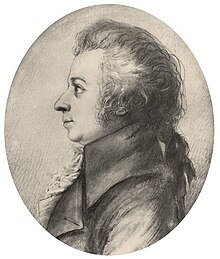Sonata in C major for piano four-hands, K. 521: Difference between revisions
Citation bot (talk | contribs) Alter: url. Add: author pars. 1-1. Removed parameters. Some additions/deletions were actually parameter name changes. | You can use this bot yourself. Report bugs here. | Suggested by AManWithNoPlan | All pages linked from cached copy of User:AManWithNoPlan/sandbox2 | via #UCB_webform_linked |
Diggers2004 (talk | contribs) m →Notable performances: add link to youtube performance |
||
| Line 44: | Line 44: | ||
== Notable performances == |
== Notable performances == |
||
Notable performances include those of the duos [[Evgeny Kissin]] and [[Martha Argerich]], and [[Ingrid Haebler]] and {{ill|Ludwig Hoffmann (pianist)|de|Ludwig Hoffmann (Pianist)|lt=Ludwig Hoffmann}}.<ref>{{Cite journal |last1=Bisesi |first1=Erica |last2=MacRitchie |first2=Jennifer |last3=Parncutt |first3=Richard |year=2013 |title=Structural communication in piano duos: Musical compatibility and individual differences in interpretation |url=https://online.uni-graz.at/kfu_online/wbFPCompsCallBacks.cbExecuteDownload?pDocStoreNr=1681901 |journal=International Symposium on Performance Science |page=1 |isbn=978-2-9601378-0-4 |access-date=9 July 2020}}</ref> |
Notable performances include those of the duos [[Evgeny Kissin]] and [[Martha Argerich]]<ref>{{Cite web|date=16 December 2021|title=Martha Argerich & Maria João Pires play Concerto for Two Pianos, KV 365. Conducted by Daniel Harding|url=https://www.youtube.com/watch?v=7fzYOtaJcxU?t=1719|url-status=live|access-date=27 January 2022|website=Youtube}}</ref>, and [[Ingrid Haebler]] and {{ill|Ludwig Hoffmann (pianist)|de|Ludwig Hoffmann (Pianist)|lt=Ludwig Hoffmann}}.<ref>{{Cite journal |last1=Bisesi |first1=Erica |last2=MacRitchie |first2=Jennifer |last3=Parncutt |first3=Richard |year=2013 |title=Structural communication in piano duos: Musical compatibility and individual differences in interpretation |url=https://online.uni-graz.at/kfu_online/wbFPCompsCallBacks.cbExecuteDownload?pDocStoreNr=1681901 |journal=International Symposium on Performance Science |page=1 |isbn=978-2-9601378-0-4 |access-date=9 July 2020}}</ref> |
||
== References == |
== References == |
||
Revision as of 23:10, 26 January 2022
| Sonata in C major for piano four-hands | |
|---|---|
| by W. A. Mozart | |
 Mozart in 1789, drawing by Dora Stock | |
| Key | C major |
| Catalogue | K. 521 |
| Style | Classical period |
| Composed | 1787 |
| Published | 1788 |
| Movements | Three (Allegro, Andante, Allegretto) |
The Sonata in C major for piano four-hands, K. 521, is a piano sonata in three movements composed by Wolfgang Amadeus Mozart in 1787. It was his last complete piano duet sonata for one piano, four hands.[1] This sonata consists of three movements: Allegro, Andante and Allegretto.
Dedication and context
In Mozart's thematic catalog, the piece was dated May 29, 1787. On that same day, he also received word of his father's death. Mozart then shared the sad news with his close friend Gottfried von Jacquin, a Viennese court official and amateur musician, and subsequently dedicated the piece to Gottfried's sister, Franziska von Jacquin.[2] In Mozart's letter to Gottfried, he noted that the piece is "rather difficult" and therefore instructed Franziska to "tackle it at once".[2]
This piece was published at the turn of the year 1787/1788 by music publisher Franz Anton Hoffmeister. Instead of Mozart's original intention to dedicate it to Franziska von Jacquin, one of his most talented pupils, it was dedicated to Nanette and Barbette Natrop, daughters of Viennese businessman Franz Wilhelm Natorp, also in the Jacquin circle.[3]
Movements
I. Allegro (C major)

The first movement begins with the Primo and Secondo parts playing in unison, presenting the main theme with both vigor and delicacy. After the initial phrase, follows an tasteful and refined dialog between Primo and Secondo. A gracious second theme comes after the sixteenth note descending scales and a slight pause at the end of the first theme.[4]
II. Andante (F major)
This slow and melancholic second movement takes a ternary form of A–B–A. The outer sections (A sections) bear a lyrical and gentle quality, while the middle section (B section) has difficult triplets runs[1] that give a rather tense feeling.[4]
III. Allegretto (C major)
The third movement is a rondo. Its main theme begins with a relaxed "music-box naivety"[4] full of glamour and humor.
Notable performances
Notable performances include those of the duos Evgeny Kissin and Martha Argerich[5], and Ingrid Haebler and Ludwig Hoffmann.[6]
References
- ^ a b Timbrell, Charles, ed. (2013). Mozart Sonatas for One Piano, Four Hands. Alfred Music. p. 3. ISBN 978-0-7390-9171-5. Retrieved 17 July 2020.
- ^ a b Robins, Brian. Wolfgang Amadeus Mozart – Sonata for piano, 4 hands in C major, K. 521 at AllMusic. Retrieved 19 June 2020.
- ^ Jost, Peter. "Wolfgang Amadeus Mozart – Works for Piano Four-hands" (PDF). G. Henle Verlag. Retrieved 3 July 2020.
- ^ a b c The Chamber Music Society of Lincoln Center. "One Piano, Four Hands - March 12, 2015". issuu.com. Retrieved 22 June 2020.
- ^ "Martha Argerich & Maria João Pires play Concerto for Two Pianos, KV 365. Conducted by Daniel Harding". Youtube. 16 December 2021. Retrieved 27 January 2022.
{{cite web}}: CS1 maint: url-status (link) - ^ Bisesi, Erica; MacRitchie, Jennifer; Parncutt, Richard (2013). "Structural communication in piano duos: Musical compatibility and individual differences in interpretation". International Symposium on Performance Science: 1. ISBN 978-2-9601378-0-4. Retrieved 9 July 2020.
External links
- Sonata for Piano Four-Hands in C major, K. 521: Scores at the International Music Score Library Project
- Sonata in C major for piano four-hands, K. 521: Score and critical report (in German) in the Neue Mozart-Ausgabe
- Video on YouTube, Susan Merdinger and Steven Greene, 2013
